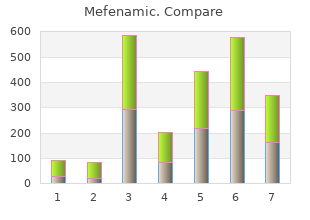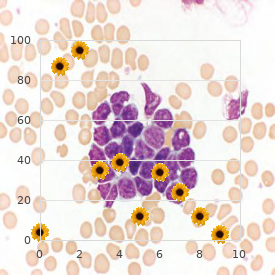Wilkes University. U. Jesper, MD: "Order Mefenamic online no RX. Cheap Mefenamic OTC.".
However order mefenamic american express spasms urethra, an additional level of definition is now possible in many hospital laboratories and may aid the practitioner in providing prognostic and genetic counseling information for patients and their families buy 500 mg mefenamic with mastercard muscle relaxant eperisone. Furthermore cheap mefenamic 250 mg overnight delivery spasms everywhere, the practitioner should recognize the importance of defining the molecular defects in the management of immune-deficient patients because several forms of specific therapy are already available and new modalities are being developed at a rapid rate as a result in advances in understanding of the physiology of lymphocytes and cytokines as well as the genome project. Importantly, within the B-cell disorders, the pattern of X-chromosome inactivation ( 60) can be used to determine whether female family members are carriers of Bruton agammaglobulinemia (61). The most likely defect can then be confirmed in specialized research laboratories using assays for the specific protein (Western blot or flow cytometry) or gene that is suspect. Fluorescence in situ hybridization can be used to confirm the chromosome abnormality in patients suspected of having DiGeorge or velocardiofacial syndrome, overlapping sets of anomalies that may be associated with partial T-cell deficiencies and are due to microdeletions in chromosome 22q11. If there is no potential donor who matches at all loci, transplantation of T-cell depleted marrow from a donor with a mismatch at one or more loci might be considered but is performed only at certain research centers. Anticoagulated whole blood should be sent to a research center with expertise in these assays ( 66) in cases of T-cell deficiency with impaired mitogen responses. For these reasons, special precautions must be initiated as soon as this type of immune defect is suspected, while the immunologic workup is proceeding and plans for referral and definitive treatment are being formulated. With current recommendations in the United States abandoning the use of the live attenuated oral polio vaccine and replacing it with inactivated vaccine only, polio is less of a risk. However, immunization with Bacille-Calmette-Gurin vaccine is practiced in many other countries and may lead to fatal infection. Trimethoprim-sulfamethoxazole or other appropriate regimens should be should be used for prophylaxis against P. This may need to be continued for more than a year, even in children who have received bone marrow transplants, because functional B-cell engraftment is often delayed. Although patients with X-linked agammaglobulinemia, X-linked hyper-IgM syndrome, and other severe immunoglobulin deficiencies generally clearly require immunoglobulin replacement (see later), others with less severe deficiencies often require complex judgment processes. In deciding which form of therapy may be most appropriate for any given patient, the practitioner must consider not only the underlying diagnosis but also the exposure history, the cumulative morbidity and future risk for end-organ damage from infection, and the risks and adverse effects of the various therapeutic options. Often, antibody-deficient patients who present with repeated acute infections also have systemic morbidity, about which they may or may not complain. This may include fatigue, lack of stamina, poor weight gain (in infants), and musculoskeletal symptoms that have been attributed to other causes or ignored. Because these symptoms often improve with appropriate management of chronic infection and immunoglobulin replacement, they must be carefully evaluated in the review of systems and weighed in considering the options for therapy. Patients with a history of inflammatory bowel disease, recurrent problems with Clostridium difficile, or drug allergies may have decreased tolerance for antibiotics, which may limit the therapeutic options in their cases. A stepwise approach to treatment may be employed across the range of severities of antibody deficiency or sequentially in any given patient. Some patients, particularly small children, with partial antibody deficiency who have not had significant permanent end-organ damage may be managed by limiting their exposure to infectious agents (e. Measurement of specific antibody titers after administration of these vaccines may provide reassurance for parents and referring physicians and may suggest that additional therapy is not indicated. In some cases of partial antibody deficiency, immunization, prompt and rigorous treatment of likely bacterial infections such as sinusitis and bronchitis, and verification that these are continued until the infection has been completely resolved may provide satisfactory control of infection and freedom from chronic or progressive symptoms. In other cases, parenteral or prolonged courses of antibiotics may be initiated upon suspicion of bacterial infection, if tolerated. Many patients attain satisfactory freedom from infection by a once-daily dose of trimethoprim-sulfamethoxazole* (e. Patients who develop diarrhea or other excessive gastrointestinal side effects, oral thrush, or vaginal candidiasis may be poor candidates for this approach or may not tolerate it for long. If isolation of the organism is not possible, or if it is not sensitive to the agent used for prophylaxis, a different agent should be used for treatment, for the full prescribed course; the prophylaxis regimen may then be resumed. The introduction of preparations of pooled immunoglobulin for intravenous use has greatly facilitated administration of doses of IgG sufficient to prevent infection satisfactorily. This has become the modality of choice for most patients, particularly in the United States. Intramuscular injections of more concentrated preparations and plasma infusions have largely been abandoned, but subcutaneous infusion is also used, particularly in Scandinavian countries ( 73). Most currently available preparations of immunoglobulin for intravenous use are made from the pooled plasma of thousands of donors and contain a broad spectrum of molecularly intact specific IgG antibodies of all four subclasses, with little or no IgM or IgE. Most preparations contain sugars such as maltose, dextrose, or others, with or without glycine as a stabilizer. The risk for viral transmission is minimized by careful screening and selection of donors, by the processes used to purify the IgG (usually a modification of the Cohn-Oncley cold alcohol precipitation procedure), and by specific viral inactivation steps ( 74).
Recently purchase mefenamic without a prescription muscle relaxant quiz, aerosolized ribavirin has been advocated to treat respiratory syncytial virus best 250 mg mefenamic spasms tamil meaning, a common cause of bronchiolitis in the midwinter and spring cheap 500mg mefenamic fast delivery muscle relaxers to treat addiction. Mycoplasma pneumoniae and Legionella pneumoniae are other infectious organisms that can cause bronchiolitis. When suspected, currently effective antibiotics include macrolides and fluoroquinolones. It can result from a viral infection, though may also be the result of inhalational injury, drug effects, or inflammation from a noninfectious systemic illness such as rheumatoid arthritis. Patients present with chronic symptoms which commonly include a persistent dry cough and shortness of breath. If initiated early, there is often a dramatic response in the first few days of steroid treatment. Bronchiectasis Bronchiectasis is defined as destruction and permanent dilatation (widening) of the large airways. Dilated airways make it difficult to clear secretions, and can collapse causing airflow obstruction and recurrent infections. A person may be born with it or may develop it later in life as a result of airway infection or inhalation injury. Many patients demonstrate abnormal defenses against infection due to problems with their immune system. Bronchiectasis can also result from an infection that does not clear due to a blocked airway, which can occur as a result of a foreign body aspiration. Certain lung infections (for example, tuberculosis or fungal infections) can lead to bronchiectasis. About half the cases of bronchiectasis in the United States today are caused by Cystic Fibrosis. This is an inherited multisystem disease that results in thick mucus which is difficult to clear. While most patients are children, up to seven percent are diagnosed at age 18 years or older. When the patient reports cough and daily production of thick sputum for months or even years, the diagnosis of bronchiectasis should be explored. About one quarter of patients report coughing up blood, usually described as streaks. The chest x-ray is abnormal in most patients with bronchiectasis, though findings can be nonspecific. A history of recurrent sinus infections may suggest an abnormality in host defense prompting specific studies of the immune system. During acute exacerbations, chest x-rays are often unchanged from prior evaluations. Treatment of bronchiectasis should focus on treating the underlying cause, controlling respiratory infections, managing secretions, and addressing complications. While the condition is irreversible, treatment can lessen symptoms and may be able to prevent additional damage. As noted above, patients can acquire bronchiectasis from several different pathways. When the cause is infection with airway obstruction due to an aspirated foreign body, a pulmonologist can try to retrieve the object by placing a flexible rubber tube into the airways called a bronchoscope. In those patients with recurrent infections due to low or missing immune system factors, replacement of the missing factor, when possible, leads to a significant reduction in the frequency of future infections. While the gene that causes cystic fibrosis has been isolated, there remains no available treatment for the primary defect. Treating acute respiratory infections is paramount when treating bronchiectasis, since infections are not only the cause of the disease but also are the cause of disease progression. All patients should be asked to submit a sputum culture in an attempt to isolate bacteria and to determine which antibiotics would work best (reported as the sensitivity of the bacteria).
Order 500 mg mefenamic. Сколько можно скинуть (похудеть) на кефирной диете?.

Medical texts frequently contain charts mefenamic 500 mg muscle relaxant pharmacology, figures cheap mefenamic 500 mg with mastercard spasms 1983 download, and other illustrative material that has been reproduced with permission from other sources purchase mefenamic 250mg with amex muscle relaxant before massage. Citation Rules with Examples for Parts of Conference Papers Components/elements are listed in the order they should appear in a reference. Risunok 6 Parartema 4 Romanize or translate titles in character-based languages (Chinese, Japanese). Ichiran-hiyo 3 or [Table 3, ] Ignore diacritics, accents, and special characters in names. Conference Publications 295 Example Entries for Name and Number/Letter of the Part 1. Part of a paper with title containing a Greek letter or other special character 7. Part of a paper with a constructed title Location (Pagination) of the Part of the Conference Paper (required) General Rules for Location (Pagination) Begin location with "p. Box 91 Part paginated separately A part such as an appendix or a group of tables may be given its own pagination and begin anew with page one. Part of a paper with no page number provided Examples of Citations to Parts of Conference Papers 1. Optical multi-channel monitoring of skin blood pulsations for cardiovascular assessment. In: 6th Congress on Equine Medicine and Surgery; 1999 Dec 12-14; Geneva, Switzerland. Appendix B, World Organisation for Animal Health Guidelines on antimicrobial resistance; p. Les fluctuations cycliques fondamentales des economies capitalists - le model [Fundamental cyclic fluctuations of capitalist economies - the model]. Annexe, Definition de la transformation de Laplace (1749-1827) [Appendix, Definition of Laplace transformation (1749-1827)]; p. In: 1986 European Meeting of the Toxicology Forum; 1986 Sep 22-26; Geneva, Switzerland. Part of a paper in a language other than English Morel E, Vialle R, Rillardon L, Guigui. Tableau 4, Comparison du groupe spondylolisthesis (n=53) au group temoin (n=300); p. Tableau 4, Comparison du groupe spondylolisthesis (n=53) au group temoin (n=300) [Table 4, Comparison of the spondylolisthesis group (n=53) with the control group (n=300)]; p. The neuropsychiatric syndrome of 9-tetrahydrocannabinol and Cannabis intoxication in naive subjects. Conference on Marihuana and Medicine; 1998 Mar 20-21; New York University School of Medicine, New York. The neuropsychiatric syndrome of Delta(9)-tetrahydrocannabinol and Cannabis intoxication in naive subjects. In: Pharming the genome: implications of pharmacogenomics for human health and public policy [Internet]. Entire Reports Sample Citation and Introduction Citation Rules with Examples Examples B. Parts of Reports Sample Citation and Introduction Citation Rules with Examples Examples A. Governmental agencies, usually at the federal or state level, issue most technical reports, but reports also originate from universities and other types of research institutions. In citing a technical report, it is important to identify both the sponsoring organization (i. For example, the National Cancer Institute has intramural scientists and may publish their work in report format. Often, however, the sponsoring organization provides funds to another organization that actually performs the research. When this occurs, either the sponsoring organization or the performing organization may publish the report. Some technical reports will have the same type of edition statement found in books, such as "2nd ed. The time period covered by the report is also often included in the edition statement.


IgA antibodies against smooth muscle endomysium are found in approximately 70% of patients order 500mg mefenamic fast delivery muscle relaxant 4211, and titers correlate with the severity of the intestinal disease order mefenamic 500 mg on-line muscle relaxant overdose. However mefenamic 250 mg overnight delivery spasms in colon, cutaneous lesions may respond more slowly to treatment and also may appear more slowly with rechallenge. Sulfones are the mainstay of therapy for the cutaneous lesions and may relieve pruritic symptoms within 24 hours ( 137). Consistent with hemosiderosis, hemosiderin-laden macrophages may be seen in biopsy samples of the lung or in stomach aspirates ( 139). The titers, however, do not correlate with disease severity, and their significance is as yet unknown ( 140). Symptoms improve when milk is eliminated from the diet and recur with rechallenge. Some patients with positive precipitins do not respond to milk elimination, whereas some with no titers do ( 142). The resultant symptoms are the same as respiratory symptoms seen with aeroallergens, rhinoconjunctivitis, and asthma. This is the most common food-related lung disease, and affects workers who are regularly exposed to flour. Bronchial provocation has shown sensitivity to flour as well as to contaminants such as insects or molds ( 147,148 and 149). A study of crab processors reported that the IgE sensitization occurs through exposure to aerosolized proteins, in this case in the steam of cooking water, thus explaining the resultant respiratory symptoms (150). This also may explain some adverse reactions that food-sensitive individuals have experienced with smelling the food, or being in close vicinity while it is cooked. In a study of salmon processing workers, 24 of 291 employees developed occupational asthma. They worked in close proximity to machines that generated aerosolized salmon serum protein; IgE antibodies to salmon serum protein was demonstrated ( 151). Of interest, 12 of 54 snow crab workers who were sensitized by inhalation and developed asthma, experienced the same reaction with ingestion of the snow crab ( 150). Of note, there have been isolated reports of anaphylaxis from ingestion of food contaminated with an aeroallergen ( 153,154). A subset of patients have these symptoms only if exercise is performed within 2 to 6 hours of food ingestion ( 156). For some patients, this postprandial exercise-induced anaphylaxis may occur with any food ingestion followed by exercise ( 156,157). Others have exercise-induced anaphylaxis only associated with the ingestion of specific foods, such as celery ( 156) or shellfish (158). These patients are skin test positive to the foods, yet they have no allergic reactions unless ingestion is followed by or preceded by rigorous exercise ( 156,158). For all food-related exercise-induced anaphylaxis, episodes are prevented with avoidance of food ingestion 4 to 6 hours prior to or following exercise ( 157). Treatment also includes carrying self-injectable epinephrine, exercising with a buddy, wearing medic alert identification, and exercising only if a medical facility is in reasonable proximity. The mechanism of this type of anaphylaxis is not well understood, but it is thought to be mediated by mast cell degranulation (155). In one study, 132 patients who responded to a survey stating they had an adverse reaction to food additives underwent different oral challenges with additives mixed in combination and with placebo capsules. Of these patients, only 3 had a consistent reaction: 2 to the natural yellow-orange annatto and one to the azo dye and the antioxidants, for an overall prevalence of 0. There were no positive oral challenges with metabisulfite in 12 patients with idiopathic anaphylaxis, and 1 patient with chronic urticaria, all of whom had reactions temporally related to restaurant meals ( 161). Two multicenter trials were conducted to evaluate claims of hypersensitivity to aspartame. These were double-blind, placebo-controlled crossover trials, one involving 40 patients presenting with headache after aspartame ingestion and the other involving 21 patients with urticaria or angioedema associated with aspartame ingestion.

